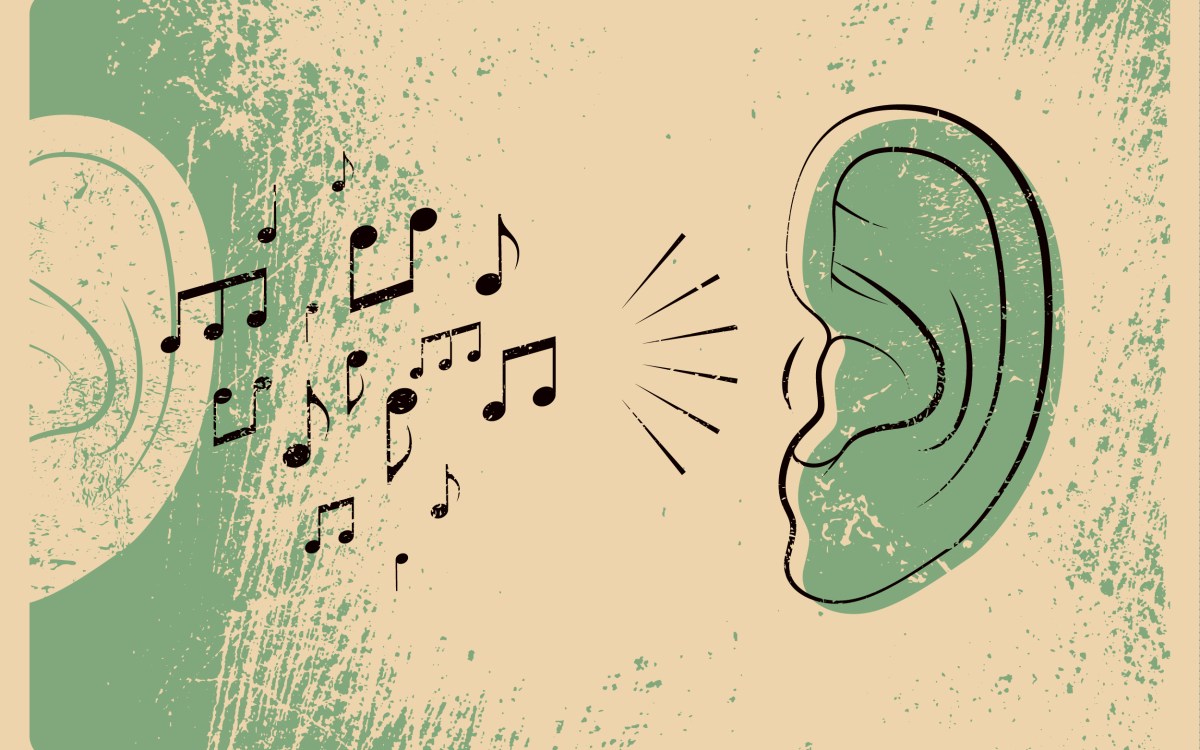
Baby Theo demonstrates the method for measuring physiological responses to lullabies. He did not participate directly in the study, but is modeling the equipment here.
Frère Jacques, are you sleeping?
Research shows lullabies in any language relax babies
Virtually all new parents quickly discover that a lullaby will in fact help an infant unwind, but they might be surprised to learn that babies aren’t fussy about the language.
Researchers at Harvard’s Music Lab have determined that American infants relaxed when played lullabies that were unfamiliar and in a foreign language. Their results were published in Nature Human Behaviour on Oct. 19.
“There’s a longstanding debate about how music affects listeners as a result of both prior experiences with music and the basic design of our psychology,” said Samuel Mehr, a Department of Psychology research associate and principal investigator at the Music Lab. “Common sense tells us that infants find the lullabies they hear relaxing. Is this just because they’ve experienced their parents’ singing before and know it means they’re safe and secure? Or is there also something universal about lullabies that produces these effects, independently of experience?”
The new findings supported the latter hypothesis: Infants responded to universal elements of songs, despite the unfamiliarity of their melodies and words, and relaxed. The study was conducted in 2018 and 2019 at the Music Lab, which focuses on the psychology of music from infancy to adulthood.
In the experiment, each infant watched an animated video of two characters singing either a lullaby or a non-lullaby. To measure the infants’ relaxation responses to the recordings, the researchers focused on pupil dilation, heart rate changes, electrodermal activity (a measure of “arousal” or excitement, from electrical resistance of the skin), frequency of blinking, and gaze direction as indicators of relaxation or agitation. Generally, the infants experienced a decrease in heart rate and pupil dilation, and attenuated electrodermal activity in response to the unfamiliar lullabies.
The researchers had to act quickly because of their subjects’ limited attention spans; most babies could pay attention for about five minutes before getting distracted.
“In an ideal world, we would play babies a dozen songs that are lullabies and a dozen songs that are not lullabies and gather a lot of data from each infant. But an infant’s attention span is short, so the experiment is short too,” said Mila Bertolo, co-first author of the research.
Researchers played infants music from around the world and found they relaxed more in response to lullabies than other types of songs. Can you identify which song is the lullaby in the clips below?
Clip 2: Healing song from the Seri of Mexico.
The songs were chosen through a previous Music Lab study, in which adults rated how likely a foreign unfamiliar song was to be a lullaby, a dance song, a healing song, or a love song. Using a cross-cultural sample of adult-rated lullabies helped the researchers avoid incorporating their own selection bias, where they might be more inclined to choose songs that most closely resembled a Western lullaby, said Bertolo.
The 16 songs selected for the experiment came from the Natural History of Song Discography, and included lullabies and other songs originally produced to express love, heal the sick, or encourage dancing. Languages like Scottish Gaelic, Hopi, and Western Nahuatl, and regions including Polynesia, Central America, and the Middle East were represented in the songs chosen.
“Melody is one of the things that sticks out for lullabies. In comparison, in a lot of other song types, such as dance songs, you would see rhythm as being more of a driving force,” explained Connie Bainbridge, who co-led the research with Bertolo in the Music Lab, and is now pursuing a Ph.D. in communication at UCLA.
Separately, researchers asked parents to listen to both types of song and choose which they would use to soothe their infant. They almost always chose the lullaby, indicating that they also recognized the universal elements of the lullaby, even subconsciously. “Calming a fussy infant is an urgent matter for parents. Those of us with kids might be particularly sensitive to the acoustic features that appear universally in lullabies, as these may be most likely to calm our infants efficiently,” said Mehr.
The findings are “a testament to how effective music is,” said Bertolo. “This piece of the puzzle helps us make sense of certain kind of downstream effects” like music therapy in clinical settings. “It’s an interesting question to see whether the same thing that drives the relaxation for infants would carry through into adulthood.”
The researchers predict that the results could be replicated with a different group of subjects from another culture. They also plan to continue investigating questions raised during the experiment, such as which of the specific acoustical elements of a lullaby encourage relaxation, how singing interacts with other activities and environments to induce relaxation, and what inferences infants might make during listening.
The research provides evidence that singing can help infants relax — and in doing so might improve daily life for both child and caregiver.
“While the music in general was relaxing, there was something about the lullabies that was especially relaxing, so in theory there could be ways to optimize the music we provide to infants, to make them more effective,” added Bainbridge. “Additionally, it’s an interesting area to explore as far as the function of music — is it an adaptation that we evolved to have or a byproduct of language or auditory cognition? Our findings do seem to support the idea that there is actually an evolutionary function of music.”
This research was supported by the NIH Director’s Early Independence Award and the Harvard Data Science Initiative.








